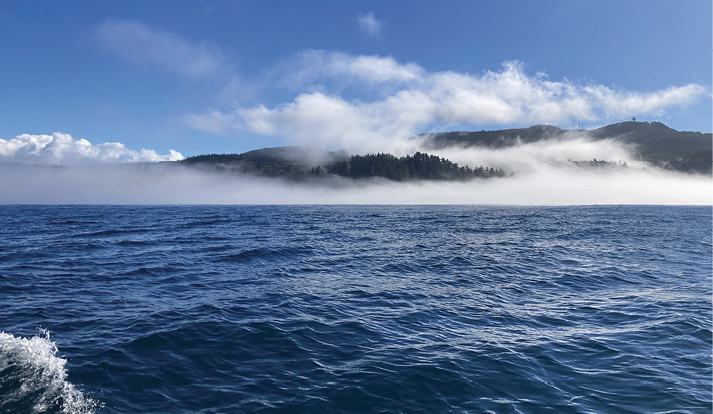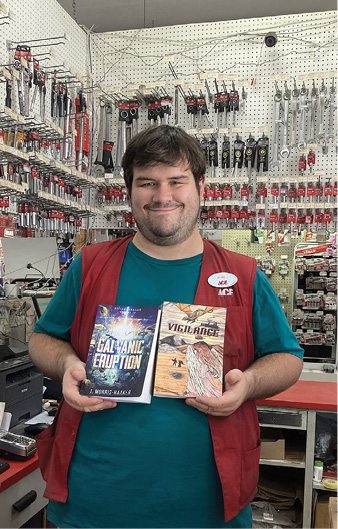Here's a story about Skip and building boats. Most of know some of this story, but not everybody might. This will be in Bay & Delta Yachtsman Magazine, but the format has changed and I can no longer just cut and paste only my own column here. So SSSers get it early but with no advertising. If you want to peruse the advertisements for a boat you'll have to wait for the magazine to come out.
SKIP ALLAN IN CAPITOLA
Anyone who has ever raced competitively in the United States and Europe knows the name Skip Allan. Impressive as he was as crew on some of the fastest boats on the water, he is also close to my own heart as a singlehanded sailor.

Skip solo sailed his boat, the Hawkfarm s/v Wildflower to Hawaii, Australia and then he trailered his catamaran Wildflower II up to the Pacific Northwest and sailed all over those waters. Skip is also also the author of two illustrated children’s books.
In January 8 of 2024 I drove down to Capitola where Skip showed me the recent damage done to his home town by storms. We looked at the damage that had been done to the row of colorful cottages known as the Historic Venetian Court properties. They were a mess.
More recently I had interviewed Steve Hutchison, who talked about living on $200/month ‘back in the day’ where he grew up in the state of Maine. Skip and I talked about the possibility of doing that now. We sat together in the sunshine on a retaining wall in front of the cottages. I was also interested in the rumour that he had built his own boat. This is what Skip told me:
“Me and the boat were one. It was a prototype of the Hawkfarm sailboat. I’d had a dream of building my own boat for a long time. Tom Wylie designed me a 33 footer that I was going to have built in New Zealand. I went there and was going to have the boat built there but during the time I was there the kiwis found out the value of their boat building skills and all of a sudden the cost of the boat there would’ve doubled So I came back home from New Zealand and Tom was drawing a design for a half ton racing boat.
At this time the half ton class was just taking off. In fact, one of his boats, s/v Animal Farm, won the long distance race in the 1973 half ton worlds in France. Tom had also designed a very successful boat called s/v Hawkeye. Animal Farm and Hawkeye had the same hull shape, it’s just that Hawkeye had a flush deck and Animal Farm had to have a cabin that had 5’8” headroom to qualify as a racer.
So Tom had designed these two boats and Animal Farm in France became well known and people came to him and said, “Tom, we want a boat like Animal Farm”. He said, ‘ok’.
BUILDING WILDFLOWER
I started working for Tom at Wylie Design Group, which was on Willow Street in Alameda. I started working for him there in 1973. We took the Animal Farm and we made a mold off it and started making Wylie half tons. We would build one boat at a time. While the mold wasn’t in use I made a deal with Tom Wylie and said, “Hey, instead of the boat I was going to build in New Zealand I’d like to use the mold for the half ton racers and build my own boat. Yes, it’ll be smaller, but I can build it stronger. I don’t want it as a race boat. It’s going to be my home and a cruising boat.
He said, “Okay, you pay me X amount of money and we’ll let you use the shop” which was a big warehouse.
I was working there and I traded hours building the half ton racers in return for being able to lay up my own boat in the shop. Once it was laid up I got pictures of it, we popped it out of the mold and we put it over in a corner of the shop. After five in the evening, when we quit in the shop, I would move over and work on my own boat.
It slowly took shape during the winter of 1974. It was going to be a simple boat and it was. We made a few modifications to the race boat. We moved the keel on it back 8” and we made it a masthead rig. There wasn’t any engine in the boat because at that time there were no diesel engines for small boats and I did not want a gas engine even if I could afford it. I built Wildflower in the Wylie shop and kept it simple.
We rolled the boat over upside down and glassed on a skeg. The rudder had a skeg in front of it which would help it steer a straight line. While the boat was upside down in the shop I was sleeping in the boat upside down. Otherwise I lived in a little trailer up at Tom Wylie’s property, which is where he still lives, up in American Canyon. I would drive down the hill to the Alameda boat shop in the morning. Driving over Skyline Drive during the Spring there would be these wildflowers EVERYWHERE! I thought: Wildflower: That’s the perfect name for the boat. So that was the boat’s name.
I finished the boat in the spring of 1975 and on Halloween we launched it at Svendsen’s in Alameda. I dedicated $500 to the launching party for the food. I had my good friend David Walley ready and as the boat was being lowered into the water at Svendsen’s Dave had the mast hanging from the hoist. The boat hit the water and the mast went into the boat and we hooked the turnbuckles up and I said, “Anybody want to sail?” While the party was happening we went sailing there off Svendsen’s in the new boat.
And the new boat was stronger than the race boats, which were built as race boats.. People would say, “Skip, why are you making the bow of this boat out of Kevlar?”
The boat eventually DID go into ice, but that’s another story.
BOAT BUILDERS OF ALAMEDA
There were other famous boat builders there working in the shop, too. Working with Tom and including Chris Benedict, Don Peters, Del Olsen, Kim Desenberg and others were building the half ton racers. Then the half ton racing class advanced and the Wylie boats weren’t as fast as the new Peterson and Lurie Davidson boats. So we weren’t selling any more of the half ton racers.
Tom says, “Well, it’s about time we have a one design class of boats on the bay. This size. The bird boats are worn out and the bear boats are worn out and the Hurricanes are worn out, so we’ll take the half ton mold and we’ll turn it into a bay racer. So we used Wildflower’s ideas. We moved the keel in the mold 15 inches because the half ton racers liked to be rated with their bow down. That was not a good way to sail but if you had a lot of weight in the back the boat was level. Well, we moved the keel aft in the mold and we built the boats wider a little bit by jacking the mold apart and we made it a little more cruisy with a little icebox in it, and a little stove and a little bit of other stuff, and we built quite a few hawkfarms, including Synthia’s s/v Eyrie and Jocelyn’s s/v Gavilan.
The class was fairly successful in the bay. I don’t know how many Hawkfarms we actually built. Probably twenty or more. [according to SailboatData.com there were 32 Hawkfarms built]. There are still a few of them around. So Wildflower was not the first out of the mold, but it was the first cruising boat which was not meant as a racing boat out of the mold.
Today you can’t find property to build a boat, or to have a boat company anyplace in the bay area because of the environmental laws that affect fiberglass and resins and stuff. Property is now so expensive, too. That warehouse where we built the boats is now expensive homes. And there are other reasons. Rents are sky high. Materials are so expensive. There aren’t any fiberglass boat building companies left in the US.
Skip shook his head and I shook my head and we decided to go to lunch. It was a good day on the beach and I am happy to share this story.


































